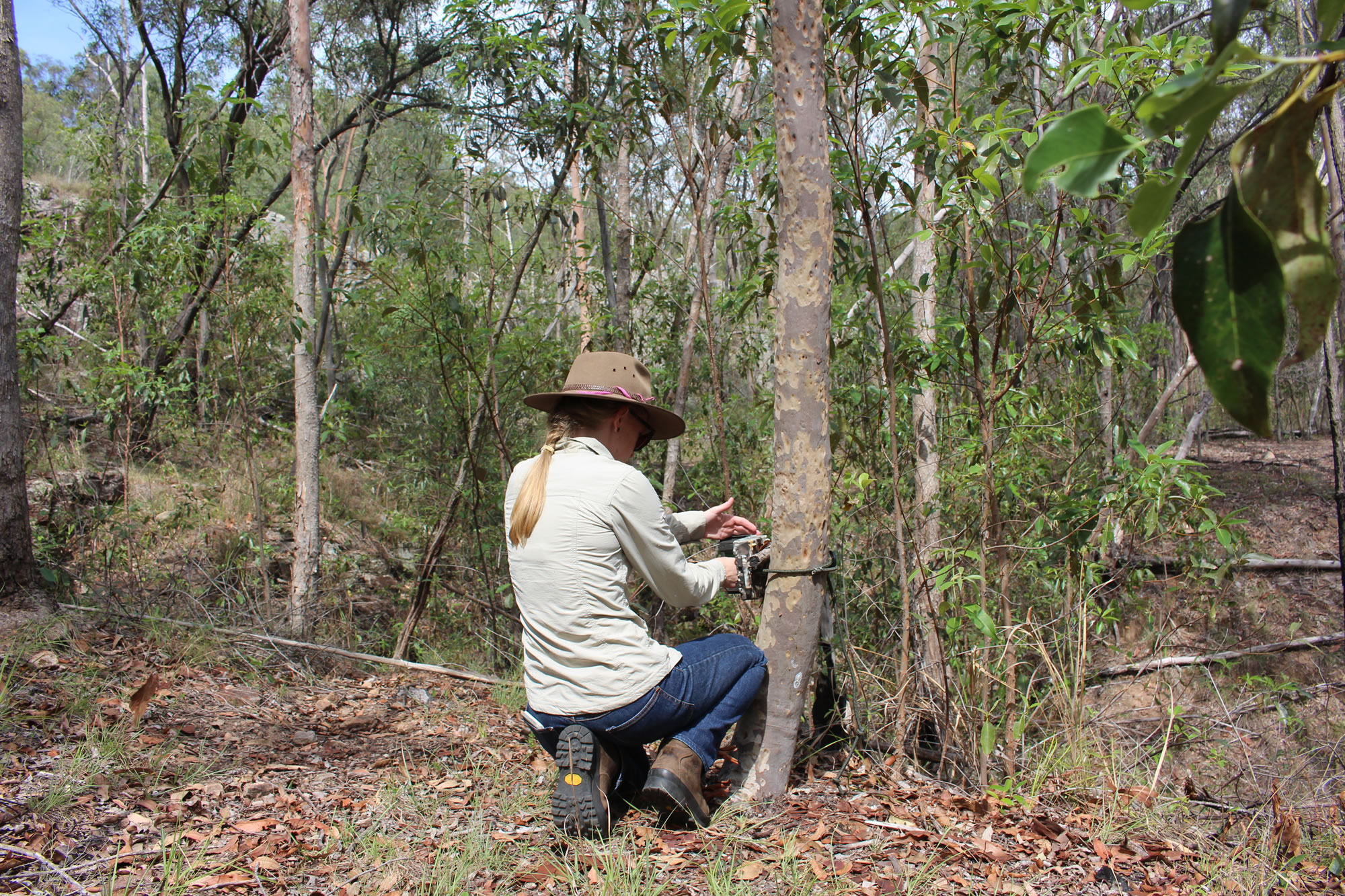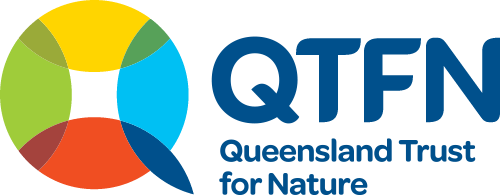Koala Crossing
Protecting an Aussie icon in the Flinders-Karawatha Corridor
The koala (Phascolarctos cinereus) in South East Queensland is under increasing pressure from urban encroachment. The marsupial needs connected corridors to move, forage and breed, and its long-term survival requires protection at a landscape level.
Koala Crossing is situated at the base of Flinders Peak, an hour south of Brisbane and just five kilometres east from the township of Peak Crossing. The 652-hectare property forms part of the Flinders-Karawatha Corridor, the largest remaining contiguous stretch of open eucalypt forest in the region.
Through our ownership and management of Koala Crossing, we are playing a vital role in protecting and enhancing critical koala habitat, and advancing our knowledge, understanding and ability to care for this iconic Australian animal.
Koala crossing is made up of eight lots, four acquired by QTFN in 2014 and the other half in 2015. Currently, four are protected as individual nature refuges with the remaining four targeted for nature refuge status.
Make your impact
- Facilitating ongoing revegetation and restoration of koala habitat through an extensive and ongoing planting program carried out in collaboration with corporate and project partners, conservation groups and community volunteers.
- Protecting existing remnant, mature regrowth and new growth areas through active fire, weed and feral pest management.
- In partnership with the University of Queensland’s Koala Ecology Group, conducting research to provide vital information on the movements, health and habits of the koala population at Koala Crossing and in the Peak Crossing area.
- Providing a safe, protected and monitored environment for the release of local injured or orphaned koalas following their rehabilitation by respected koala rescue organisations.
- Using fire and direct seeding of native grasses to control the invasive creeping lantana (Lantana montevidensis).
- Conducting research to estimate the population of the vulnerable brush-tailed rock-wallaby (Petrogale penicillate) in the Flinders-Goolamon area.
WIRES-Landcare Wildlife Relief and Recovery Grant
- In 2020, QTFN was a successful recipient of a WIRES-Landcare Wildlife Relief and Recovery Grant. This follows the devasting summer that saw significant areas of our south east Queensland scrub impacted by wildlife and many years of prolonged drought.
- Through this grant, QTFN set out to drought proof Koala Crossing – a 650ha koala conservation property in the Flinders Karawatha Corridor, SEQ. Click here to read more.
Check out some of our videos from Koala Crossing here!

- Data from Spot Assessment Technique (SAT) surveys conducted in 2015 and 2019 indicated Koala Crossing’s koala population has increased in density, showing the proportion of sites with koala activity increasing from 75 per cent to 83 per cent.
- In 2020, opportunistic scat surveys conducted across the property confirmed active koala occupancy, providing further proof of a healthy (and growing) koala population.
- Koala Crossing features four different ecosystems – one of which is ‘endangered’ and the other categorised as ‘of concern’ biodiversity status.
- Almost 100,000 koala food and shelter trees have been planted in collaboration with Greenfleet, with ongoing revegetation and restoration work continuing.
- In 2020, a further 7,262 koala habitat trees were planted, bringing the total number of hectares of revegetation to 95.66 hectares with forecast carbon sequestration measuring close to 100,000 tonnes carbon dioxide equivalent (CO2-e).
- Our koala tagging, tracking and monitoring program has identified individual koalas roam across 20-100 hectares, and helped pinpoint areas for revegetation with their preferred Eucalyptus species Corymbia citriodora, Eucalyptus tereticornis and Eucalyptus crebra.
- The roll out of the award-winning Accounting for Nature framework at Koala Crossing provided an initial Environmental Condition Index (EcondTM) score/s for the property in 2020. The score between 0 and 100 that describes the condition of the asset relative to its undegraded state. The Econd™ for Koala Crossing shows strong improvements in native vegetation (40 to 70), native mammals (40 to 60) and importantly, the koala (68 to 82) in the five years QTFN has been managing the property.
- In addition to koala, Koala Crossing’s diverse ecosystems support other vulnerable native species through providing habitat for the brush-tailed rock-wallaby, grey-headed flying-fox (Pteropus poliocephalus), tusked frog (Adelotus brevis), collared delma (Delma torquata), glossy black-cockatoo (Calyptohynchus lathami), powerful owl (Ninox strenua), black-breasted button-quail (Turnix melanogaster), and southern sub-species of spotted-tailed quoll (Dasyurus maculatus maculatus).
- Protection of habitat in perpetuity under nature refuge.
- Seven injured or orphaned koala released to date.
- Greenfleet
- University of Queensland
- The World As I Am
- Accounting for Nature
- WIRES
- Landcare Australia
- Ipswich Koala Protection Society
- Community volunteers

Action & Insight
Home Sweet Hollow: Containers For Change funds new nest boxes
Thanks to everyone’s Containers for Change donations, we were able to buy two new nest boxes. Bought from Sunshine Coast based organisation Hollow Log Homes, these nest boxes will act as artificial hollows for wildlife. Wildlife use tree hollows to nest and for shelter. The goal is for these nest boxes to supplement natural hollow habitat […]
Watergum Community Koala Education Workshop
On 18 November 2023, the Watergum community came together for a koala education workshop at Koala Crossing, one of QTFN’s Revolving Fund properties. The workshop focused on helping koala enthusiasts learn more about how to establish and conserve koala habitats, understand the challenges koalas face, and engage in koala survey activities. Dave Madden, QTFN’s Restoration Project […]
Koala Crossing Nature Refuge
Earlier this year, we had great legislative success on one of our long-term properties. Koala Crossing, on Yuggera country in Peak Crossing, has had half of the land secured and gazetted as four individual nature refuges. The Koala Crossing Nature Refuge, Glider’s Glade Nature Refuge, Wallabies Knoll Nature Refuge and Cockatoo’s Corner Nature Refuge combined, provides 368ha […]
Our work
- Facilitating ongoing revegetation and restoration of koala habitat through an extensive and ongoing planting program carried out in collaboration with corporate and project partners, conservation groups and community volunteers.
- Protecting existing remnant, mature regrowth and new growth areas through active fire, weed and feral pest management.
- In partnership with the University of Queensland’s Koala Ecology Group, conducting research to provide vital information on the movements, health and habits of the koala population at Koala Crossing and in the Peak Crossing area.
- Providing a safe, protected and monitored environment for the release of local injured or orphaned koalas following their rehabilitation by respected koala rescue organisations.
- Using fire and direct seeding of native grasses to control the invasive creeping lantana (Lantana montevidensis).
- Conducting research to estimate the population of the vulnerable brush-tailed rock-wallaby (Petrogale penicillate) in the Flinders-Goolamon area.
WIRES-Landcare Wildlife Relief and Recovery Grant
- In 2020, QTFN was a successful recipient of a WIRES-Landcare Wildlife Relief and Recovery Grant. This follows the devasting summer that saw significant areas of our south east Queensland scrub impacted by wildlife and many years of prolonged drought.
- Through this grant, QTFN set out to drought proof Koala Crossing – a 650ha koala conservation property in the Flinders Karawatha Corridor, SEQ. Click here to read more.
Check out some of our videos from Koala Crossing here!

Our impact
- Data from Spot Assessment Technique (SAT) surveys conducted in 2015 and 2019 indicated Koala Crossing’s koala population has increased in density, showing the proportion of sites with koala activity increasing from 75 per cent to 83 per cent.
- In 2020, opportunistic scat surveys conducted across the property confirmed active koala occupancy, providing further proof of a healthy (and growing) koala population.
- Koala Crossing features four different ecosystems – one of which is ‘endangered’ and the other categorised as ‘of concern’ biodiversity status.
- Almost 100,000 koala food and shelter trees have been planted in collaboration with Greenfleet, with ongoing revegetation and restoration work continuing.
- In 2020, a further 7,262 koala habitat trees were planted, bringing the total number of hectares of revegetation to 95.66 hectares with forecast carbon sequestration measuring close to 100,000 tonnes carbon dioxide equivalent (CO2-e).
- Our koala tagging, tracking and monitoring program has identified individual koalas roam across 20-100 hectares, and helped pinpoint areas for revegetation with their preferred Eucalyptus species Corymbia citriodora, Eucalyptus tereticornis and Eucalyptus crebra.
- The roll out of the award-winning Accounting for Nature framework at Koala Crossing provided an initial Environmental Condition Index (EcondTM) score/s for the property in 2020. The score between 0 and 100 that describes the condition of the asset relative to its undegraded state. The Econd™ for Koala Crossing shows strong improvements in native vegetation (40 to 70), native mammals (40 to 60) and importantly, the koala (68 to 82) in the five years QTFN has been managing the property.
- In addition to koala, Koala Crossing’s diverse ecosystems support other vulnerable native species through providing habitat for the brush-tailed rock-wallaby, grey-headed flying-fox (Pteropus poliocephalus), tusked frog (Adelotus brevis), collared delma (Delma torquata), glossy black-cockatoo (Calyptohynchus lathami), powerful owl (Ninox strenua), black-breasted button-quail (Turnix melanogaster), and southern sub-species of spotted-tailed quoll (Dasyurus maculatus maculatus).
- Protection of habitat in perpetuity under nature refuge.
- Seven injured or orphaned koala released to date.
Who’s involved
- Greenfleet
- University of Queensland
- The World As I Am
- Accounting for Nature
- WIRES
- Landcare Australia
- Ipswich Koala Protection Society
- Community volunteers

Action & insight
Action & Insight
Home Sweet Hollow: Containers For Change funds new nest boxes
Thanks to everyone’s Containers for Change donations, we were able to buy two new nest boxes. Bought from Sunshine Coast based organisation Hollow Log Homes, these nest boxes will act as artificial hollows for wildlife. Wildlife use tree hollows to nest and for shelter. The goal is for these nest boxes to supplement natural hollow habitat […]
Watergum Community Koala Education Workshop
On 18 November 2023, the Watergum community came together for a koala education workshop at Koala Crossing, one of QTFN’s Revolving Fund properties. The workshop focused on helping koala enthusiasts learn more about how to establish and conserve koala habitats, understand the challenges koalas face, and engage in koala survey activities. Dave Madden, QTFN’s Restoration Project […]
Koala Crossing Nature Refuge
Earlier this year, we had great legislative success on one of our long-term properties. Koala Crossing, on Yuggera country in Peak Crossing, has had half of the land secured and gazetted as four individual nature refuges. The Koala Crossing Nature Refuge, Glider’s Glade Nature Refuge, Wallabies Knoll Nature Refuge and Cockatoo’s Corner Nature Refuge combined, provides 368ha […]

